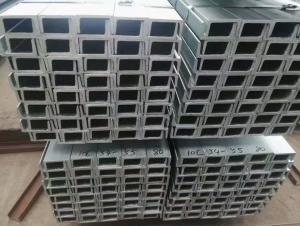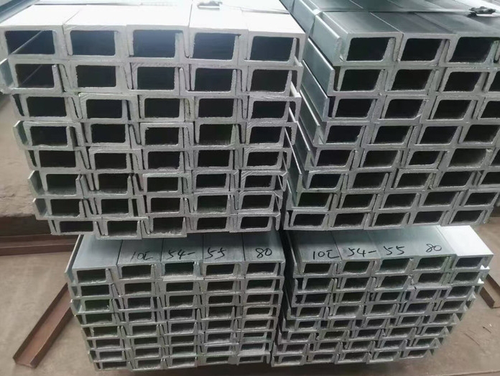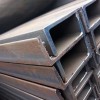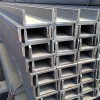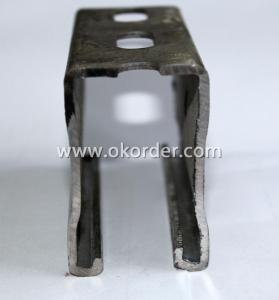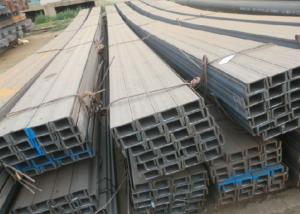ms channel bar u channel black galvanized steel channel section
- Loading Port:
- Tianjin
- Payment Terms:
- TT OR LC
- Min Order Qty:
- 25 m.t.
- Supply Capability:
- 200000 m.t./month
OKorder Service Pledge
Quality Product, Order Online Tracking, Timely Delivery
OKorder Financial Service
Credit Rating, Credit Services, Credit Purchasing
You Might Also Like
Specification
Standard:
ASTM,EN,JIS
Technique:
Hot Rolled,Cold Rolled
Shape:
U Channel
Surface Treatment:
Galvanized,Black
Steel Grade:
Q235B,Q355B,SS400,S235JR,ASTM A36 ect
Certification:
SGS,BV
Thickness:
4.5-12.5
Width:
50-400
Length:
1-12m or customized
Net Weight:
5.438-65.208kg/m
We supply ms equal & unequal angle bar, channel bar,jis channel, upn, steel i beam,h beam, ipe, ipeaa, steel sheet pile, flat bar, hollow section, tmt bar, wire rod, binding wire, wire mesh, hrc, CRC, gi coil, ppgi, roofing sheet, chequered coil & plates, medium plate, scaffolding systems, prefabricated container houses etc. Also for metal & steel processing.
If you are in the market for any steel products, please feel free to contact us.
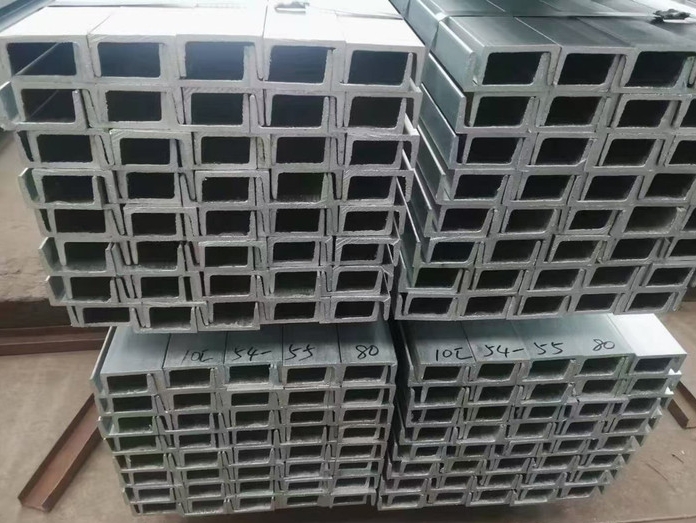

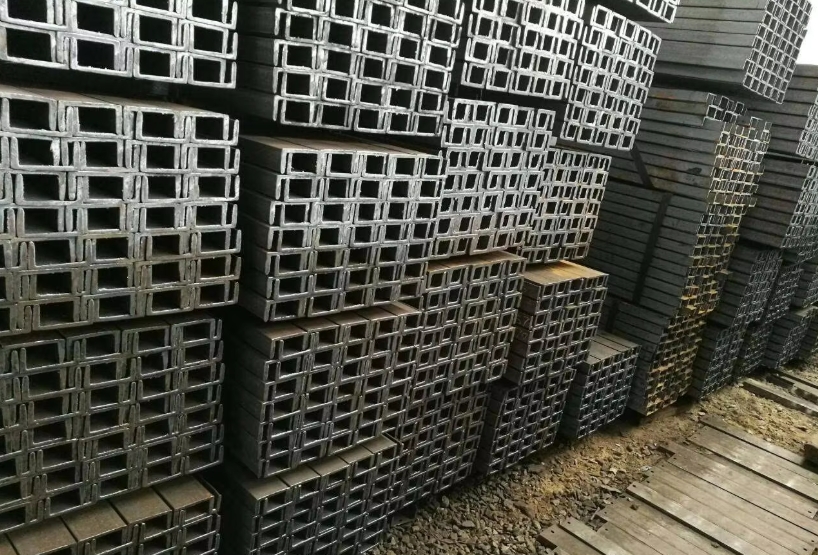
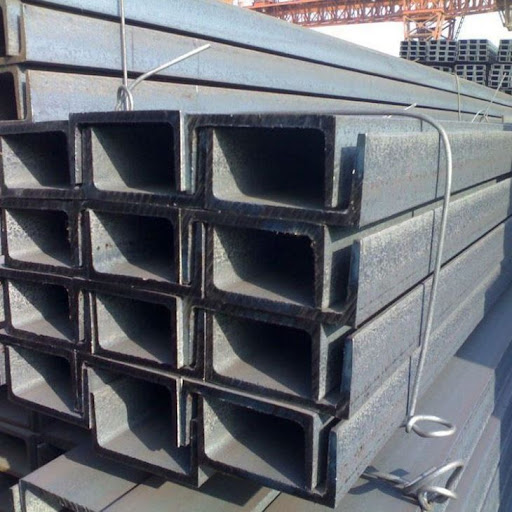
- Q: Can steel channels be used in marine environments?
- Yes, steel channels can be used in marine environments. However, it is important to choose the right type of steel and apply appropriate corrosion protection measures to ensure their longevity and performance in such conditions. Marine environments are known for their high levels of moisture, saltwater exposure, and corrosive elements, which can lead to accelerated corrosion and degradation of metals. When selecting steel channels for marine applications, materials with high corrosion resistance, such as stainless steel or galvanized steel, are recommended. Stainless steel, in particular, is highly resistant to corrosion and can withstand the harsh conditions of marine environments. Galvanized steel, on the other hand, is coated with a layer of zinc, which provides a protective barrier against corrosion. Furthermore, it is essential to implement proper maintenance and inspection practices to detect and address any signs of corrosion or damage promptly. Regular cleaning, removing any marine growth, and applying protective coatings can help extend the lifespan of steel channels in marine environments. In conclusion, while steel channels can be used in marine environments, it is crucial to select the appropriate type of steel and apply proper corrosion protection measures to ensure their durability and performance in these challenging conditions.
- Q: What are the common material testing procedures for steel channels?
- Common material testing procedures for steel channels include tensile testing, hardness testing, impact testing, and dimensional inspection. Tensile testing involves pulling a sample of the steel channel until it breaks to determine its strength and ductility. Hardness testing measures the resistance of the steel to indentation or scratching, providing an indication of its overall toughness. Impact testing assesses the steel's ability to withstand sudden, high-force impacts. Dimensional inspection ensures that the steel channels meet the required size and shape specifications.
- Q: How do steel channels contribute to seismic resistance?
- Several factors contribute to the seismic resistance provided by steel channels. Firstly, their shape and design make them highly resistant to bending and deformation when subjected to seismic forces. This structural integrity ensures the stability and strength of the building during an earthquake. Additionally, steel channels are commonly utilized as part of the building's lateral load resisting system, effectively distributing and dissipating seismic forces throughout the structure. Moreover, steel channels can be employed to reinforce and strengthen other structural elements like columns and beams. By incorporating steel channels into these components, their load-bearing capacity and resistance to seismic forces can be significantly improved. This reinforcement plays a crucial role in preventing collapse or substantial damage to the building during seismic events. Furthermore, steel channels can be strategically positioned within the building's frame to create a moment-resisting frame system. This system facilitates the transfer and distribution of seismic forces across the structure, reducing the concentration of forces on specific elements and enhancing overall resistance to seismic events. Utilizing steel channels in this manner improves the building's overall stability and ability to withstand seismic forces. Additionally, steel channels can be utilized in the construction of seismic bracing systems. These systems are designed to absorb and dissipate seismic energy, minimizing the impact on the building's structure. By incorporating steel channels into the bracing system, the building's resistance to seismic forces is greatly enhanced. In conclusion, steel channels play a critical role in improving a building's seismic resistance. Their shape, strength, and ability to reinforce other structural elements contribute to the overall stability and integrity of the building during earthquakes. By incorporating steel channels into the design and construction process, the risk of damage and collapse due to seismic events can be significantly reduced.
- Q: What are the common design considerations for steel channels?
- To ensure the proper design of steel channels, several important factors must be taken into account. These considerations include: 1. Load capacity: The primary focus when designing steel channels is their ability to bear loads. Engineers must calculate the maximum expected loads and choose a channel size and material that can safely support these loads without excessive deflection or failure. 2. Material selection: Steel channels are available in different materials, such as carbon steel and stainless steel. The selection of the material depends on various factors, including required strength, corrosion resistance, and cost. Different steel grades have distinct mechanical properties, so the appropriate material should be chosen based on the specific application. 3. Structural stability: Steel channels must have sufficient structural stability to resist buckling or collapsing under applied loads. The design should consider factors like channel length, support conditions, and the possibility of lateral torsional buckling. By analyzing these factors, engineers can take appropriate design measures to ensure the channel's stability. 4. Connection design: Another crucial consideration is the design of connections between steel channels and other structural elements. These connections must effectively and securely transfer loads, guaranteeing the overall structural integrity of the system. Proper connection design requires considering factors such as joint type, fastener selection, and weld design. 5. Fire resistance: In certain applications, fire resistance is a critical concern for steel channels. The design should incorporate appropriate fire protection measures, such as intumescent coatings or fire-resistant insulation materials, to meet the required fire rating. 6. Manufacturing constraints: The design must also account for manufacturing constraints involved in producing steel channels. This includes considerations like standard sizes, manufacturing tolerances, and the availability of specific profiles. By working within these constraints, engineers can optimize the design for ease of production and cost-effectiveness. In conclusion, designing steel channels requires careful consideration of factors such as load capacity, material selection, structural stability, connection design, fire resistance, and manufacturing constraints. By addressing these factors, engineers can develop safe and efficient designs for steel channels that meet the specific requirements of the intended application.
- Q: How are steel channels used in the construction of warehouses?
- Due to their strength and versatility, steel channels find common usage in warehouse construction. Their primary function is to provide support and structural stability to the building. This is achieved by using them as beams or columns to evenly distribute heavy loads throughout the warehouse. Steel channels can withstand the weight of storage racks, equipment, and inventory, making them an indispensable component in warehouse construction. Aside from their role in structural support, steel channels also serve framing and bracing purposes. They help establish a framework for the building, allowing for the installation of walls, roofs, and other components. By doing so, steel channels ensure that the warehouse is capable of withstanding external forces such as wind and seismic loads. In addition, steel channels find application in constructing mezzanine floors within warehouses. These intermediate levels are commonly used for storage or office space and require sturdy and durable support. Steel channels provide the necessary strength and stability to ensure the safety and functionality of these additional levels. Furthermore, steel channels are frequently utilized in the construction of conveyor systems in warehouses. These systems facilitate the transportation of goods and materials throughout the facility. Steel channels provide a robust base for the conveyor belts, ensuring smooth and efficient movement of items. In summary, steel channels have a crucial role in warehouse construction, fulfilling functions such as providing structural support, framing, bracing, and support for mezzanine floors and conveyor systems. Their durability, strength, and versatility make them an ideal choice for warehouse construction, guaranteeing the safety, efficiency, and longevity of these structures.
- Q: Are steel channels suitable for use in conveyor systems?
- Yes, steel channels are suitable for use in conveyor systems. Steel channels provide strong structural support and are highly durable, making them ideal for use in heavy-duty applications such as conveyor systems. They can withstand heavy loads and can be easily customized to fit specific conveyor requirements. Additionally, steel channels have excellent resistance to wear, corrosion, and temperature fluctuations, ensuring prolonged and reliable performance in conveyor systems.
- Q: How do steel channels contribute to the stability of roofing structures?
- Steel channels contribute to the stability of roofing structures in several ways. Firstly, steel channels are commonly used as purlins, which are horizontal beams that provide support and stability to the roof. These purlins are typically placed perpendicular to the rafters or trusses and are attached to them, creating a strong and rigid framework. The steel channels distribute the weight of the roof evenly across the structure, preventing excessive deflection and ensuring the overall stability of the roofing system. Moreover, steel channels are known for their high strength-to-weight ratio, which means they can support heavy loads without adding excessive weight to the structure. This is particularly important in roofing structures, as they need to bear the weight of the roof materials, such as tiles or metal sheets, as well as any additional loads, such as snow or wind. The use of steel channels allows for the construction of lightweight yet sturdy roofs, enhancing the overall stability of the structure. Furthermore, steel channels provide resistance against structural movements and deformations. They help to prevent sagging or buckling of the roof, which can occur due to the constant exposure to external forces, such as wind or seismic activity. The rigidity and strength of steel channels make them highly resistant to bending or warping, ensuring that the roof remains stable and secure over time. In addition, steel channels offer durability and longevity to roofing structures. They are resistant to corrosion, rust, and decay, which can be common issues in roofing materials exposed to the elements. This resistance ensures that the steel channels maintain their structural integrity, allowing the roof to remain stable and functional for an extended period. Overall, the use of steel channels in roofing structures significantly contributes to their stability by providing a strong, lightweight, and rigid framework. These channels distribute the weight evenly, resist structural movements, and offer durability, ensuring a stable and long-lasting roofing system.
- Q: How do steel channels contribute to building aesthetics?
- Steel channels contribute to building aesthetics in several ways. First and foremost, steel channels are often used as structural elements in buildings, providing strength and stability to the overall structure. However, they also play a significant role in enhancing the visual appeal of a building. One of the key ways steel channels contribute to building aesthetics is through their sleek and modern appearance. Steel channels have clean lines and a smooth surface, which can give a building a contemporary and sophisticated look. They can be used in various architectural designs, ranging from industrial to minimalist, adding a touch of elegance and sophistication to the overall aesthetic. Additionally, steel channels offer versatility in terms of design possibilities. They can be easily customized and fabricated into different shapes and sizes, allowing architects and designers to create unique and visually striking elements. Steel channels can be used as decorative features, such as handrails, balustrades, or window frames, adding visual interest and architectural detailing to the building. Moreover, steel channels can be finished with different coatings or treatments to further enhance their aesthetic appeal. They can be painted in various colors to match the overall design scheme or can be left exposed, showcasing the natural beauty of steel. Additionally, they can be polished or brushed to achieve different textures and finishes, adding depth and character to the building's appearance. Furthermore, steel channels can contribute to the aesthetics of a building by creating a sense of openness and transparency. When used as structural elements in facades, they can support large glass panels, allowing for expansive views and natural light to enter the building. This creates a visually pleasing and inviting atmosphere, connecting the interior spaces with the surrounding environment. In conclusion, steel channels contribute to building aesthetics by providing a sleek and modern appearance, offering design versatility, facilitating customization, and creating a sense of openness. With their clean lines, smooth surface, and various finishing options, steel channels can enhance the visual appeal of a building, adding elegance, sophistication, and architectural detailing to the overall design.
- Q: How do steel channels perform under live loads?
- Steel channels are highly durable and reliable structural components that are commonly used in construction projects. When it comes to their performance under live loads, steel channels exhibit excellent load-bearing capabilities. They have the ability to support heavy loads and distribute them evenly along their length, making them suitable for applications where live loads, such as people or equipment, are present. The design of steel channels allows them to efficiently resist bending and buckling, ensuring the integrity and stability of the structure. The shape and cross-section of steel channels provide a high moment of inertia, which contributes to their superior load-carrying capacity. This means that they can withstand larger live loads without experiencing excessive deflection or deformation. Additionally, steel channels offer high strength-to-weight ratio, making them an ideal choice for structures that require considerable load-bearing capacity while keeping the weight of the structure at a minimum. This advantage makes steel channels particularly suitable for applications where the weight of the structure needs to be minimized, such as in bridges or overhead cranes. Moreover, steel channels are highly resistant to fatigue, which means that they can withstand repeated loading and unloading without experiencing any significant loss in performance. This characteristic makes them well-suited for applications that involve dynamic loads, such as moving vehicles or heavy machinery. In summary, steel channels perform exceptionally well under live loads. They have the ability to support heavy loads, distribute them evenly, resist bending and buckling, and withstand repeated loading. These qualities make steel channels a reliable and efficient choice for various construction projects that require superior load-bearing capacity and structural stability.
- Q: How do steel channels perform in terms of thermal insulation?
- Steel channels do not provide a significant amount of thermal insulation. As steel is a good conductor of heat, it allows heat to easily transfer through the material. This means that steel channels can act as a thermal bridge, allowing heat to escape or enter a building. To improve thermal insulation in a steel structure, additional insulation materials such as foam or mineral wool can be added to reduce heat transfer and enhance energy efficiency.
Send your message to us
ms channel bar u channel black galvanized steel channel section
- Loading Port:
- Tianjin
- Payment Terms:
- TT OR LC
- Min Order Qty:
- 25 m.t.
- Supply Capability:
- 200000 m.t./month
OKorder Service Pledge
Quality Product, Order Online Tracking, Timely Delivery
OKorder Financial Service
Credit Rating, Credit Services, Credit Purchasing
Similar products
Hot products
Related keywords
